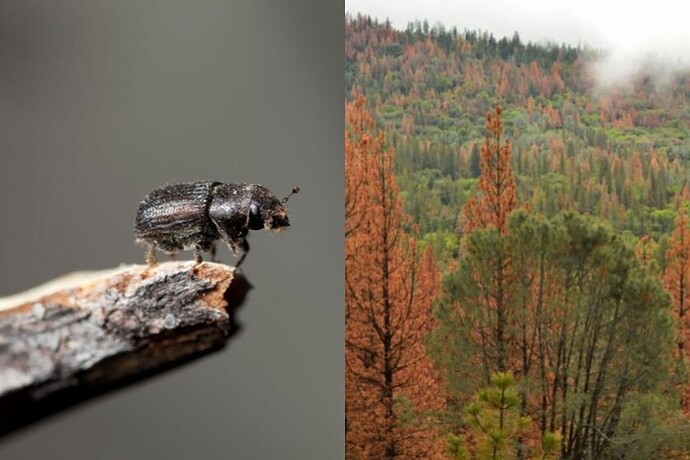Mountain pine beetle is No. 1 invasive insect priority
Researchers at the Minnesota Invasive Terrestrial Plants and Pests Center (MITPPC) are preparing for the impending arrival of one of the top threats to Minnesota’s trees.
Getty Images
By Brian Aukema, University of Minnesota
August 13, 2022 06:10 PM
For decades, the mountain pine beetle has caused an unprecedented amount of forest mortality in western North America, tearing through pine stands from the Pacific Coast all the way to the Black Hills of South Dakota.
Now, researchers at the Minnesota Invasive Terrestrial Plants and Pests Center (MITPPC) are preparing for the impending arrival of one of the top threats to Minnesota’s trees.
Brian Aukema answers questions about the species and why they pose a threat to Minnesota pine forests.
Question: What is a mountain pine beetle?
The mountain pine beetle is a small bark beetle native to the forests of western North America. Adult beetles chew through the bark of pine trees and lay eggs. Developing larvae tunnel under the bark to feed, destroying water-conducting tissues. A tree may withstand a few beetles, but large infestations of beetles will overwhelm a tree, and sustained outbreaks can cover large areas that turn pine forests from green to red very quickly.
ADVERTISEMENT
Question: Do researchers expect the mountain pine beetle to arrive in Minnesota?
Pine forests of the Black Hills of South Dakota host the nearest populations of mountain pine beetle, which are only 500 miles away from the nearest mature pine forests in Minnesota.
A warming climate, unprecedented population of beetles, and firewood and timber transport could help this destructive forest pest make its way across the prairie divide. That’s why, even though researchers have yet to find mountain pine beetle in the state, MITPPC has ranked it as the No. 1 invasive insect priority for research funding.
Question: Has research to date indicated that we should continue to be vigilant?
Mountain pine beetle can be a challenging insect to work with because it only flies once per year and it prefers to attack live trees. These nuances make laboratory studies challenging, combined with the fact that we cannot risk accidentally introducing the species to Minnesota with any live tree studies here.
Hence, we have taken logs of pine from species present in Minnesota that mountain pine beetle has not seen before and brought them to areas of mountain pine beetle activity out west. There, we have found that mountain pine beetles can tunnel into, attract mates and successfully reproduce in our pines. Whether these patterns would hold up in live trees we do not know, but it underlines continued cause for concern.
Question: What are researchers working on currently?
We are working at a few different fronts. For example, if mountain pine beetle arrives, it would need to assimilate into pine forests with flora and fauna very different from the area from which it came.
ADVERTISEMENT
We have been studying whether species of competing insects and predators would recognize mountain pine beetle, if it were to arrive, to get an idea of how they might interact.
We’ve also been working on how likely it might be that pioneering beetles would blow in. We know that beetles can fly or be blown long distances when searching for mates or a new tree. We have been investigating whether beetles captured far from infested forest lands have lower concentrations of lipids. Lipids help indicate how much “fuel” an insect has after exertion, just like in humans. If insects survive a marathon journey, would they be in any condition to colonize trees?
Question: How do you hope this research will better prepare the state for the impending arrival of the species?
This research has an immediate application to helping keep Minnesota’s forests safe. Our findings can help inform quarantine regulations, which are critical to keep this insect out of our beloved state.
Monitoring forests for mountain pine beetle is also essential to demonstrate that these quarantine regulations are working. It’s not every day that a funding agency has the capacity to fund proactive research rather than reacting to realized threats, as we so often need to do with invasive species. We greatly appreciate the support of MITPPC and the Albert Victor Ravenholt Fund for investing in this work because the data continues to show it is a continuing problem that we need to take seriously.
Brian Aukema, Ph.D., is a professor in the College of Food, Agricultural and Natural Resource Sciences and a researcher at the Minnesota Invasive Terrestrial Plants and Pests Center. His areas of expertise are forest entomology, invasive species and climate change, and ecological statistics.
